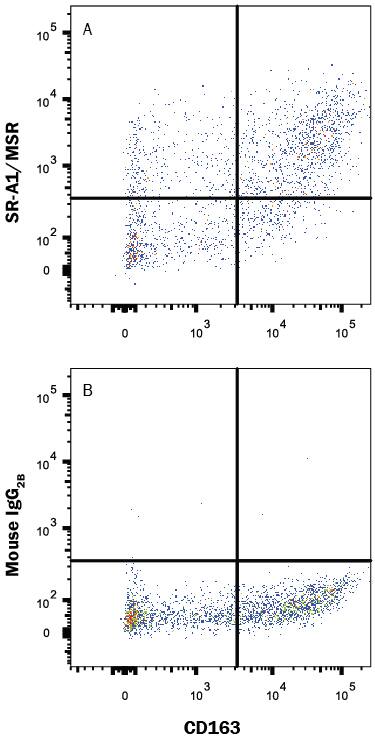Human SR-AI/MSR APC-conjugated Antibody
R&D Systems, part of Bio-Techne | Catalog # FAB2708A


Key Product Details
Species Reactivity
Validated:
Cited:
Applications
Validated:
Cited:
Label
Antibody Source
Product Specifications
Immunogen
Lys77-Leu451
Accession # P21757
Specificity
Clonality
Host
Isotype
Scientific Data Images for Human SR-AI/MSR APC-conjugated Antibody
Detection of SR‑AI/MSR in THP‑1 Human Cell Line by Flow Cytometry.
THP-1 human acute monocytic leukemia cell line activated with PMA and Ca2+ionomycin was stained with Mouse Anti-Human SR-AI/MSR APC-conjugated Monoclonal Antibody (Catalog # FAB2708A, filled histogram) or isotype control antibody (Catalog # IC0041A, open histogram). View our protocol for Staining Membrane-associated Proteins.Detection of SR‑AI/MSR in Human M2 Macrophages by Flow Cytometry.
Human M2 macrophages were stained with Mouse Anti-Human CD163 PE-conjugated Monoclonal Antibody (Catalog # FAB1607P) and either (A) Mouse Anti-Human SR-AI/MSR APC-conjugated Monoclonal Antibody (Catalog # FAB2708A) or (B) Mouse IgG2BAllophycocyanin Isotype Control (Catalog # IC0041A). View our protocol for Staining Membrane-associated Proteins.Applications for Human SR-AI/MSR APC-conjugated Antibody
Flow Cytometry
Sample: THP‑1 human acute monocytic leukemia cell line activated with PMA and Ca2+ ionomycin and human M2 macrophages
Formulation, Preparation, and Storage
Purification
Formulation
Shipping
Stability & Storage
- 12 months from date of receipt, 2 to 8 °C as supplied.
Background: SR-AI/MSR
The type I class A macrophage scavenger receptor (SR-AI; also MSR-AI) is a 70-80 kDa protein that belongs to the scavenger receptor superfamily (1‑3). Receptors of this family contain characteristic extracellular domains and bind to a series of generally unrelated, but negatively-charged/polyanionic ligands (1, 3). Human SR-AI is a type II transmembrane glycoprotein that is 451 amino acids (aa) in length. It contains a 50 aa cytoplasmic tail, a 26 aa transmembrane segment and a 375 aa extracellular region (4, 5). The extracellular region contains four definitive domains, with a membrane proximal spacer of 33 aa, an alpha-helical coiled-coil domain of 163 aa, a collagen-like domain of 69 aa, and a cysteine-rich C-terminus of 110 aa (4, 6). The cysteine-rich domain (CRD) forms three intrachain disulfide bonds (7). The functional form of the molecule is a 220‑230 kDa membrane-associated trimer that, in human, apparently has two disulfide bonded chains and a third noncovalently associated subunit (8, 9). Human extracellular region is 73% and 72% aa identical to bovine and mouse SR-AI extracellular region, respectively. The human gene for SR-A gives rise to three isoforms; the I isoform of 451 aa, the II isoform of 358 aa, and the III isoform of 388 aa (4, 5, 10). All are identical through the first 344 aa which includes the cytoplasmic tail through the collagenous domain. Isoform II (SR-AII) shows a severe truncation of the CRD, but is expressed on the cell surface. Isoform III (SR-AIII) has a modest truncation of the CRD, and cannot be expressed on the cell surface. However, relative to SR-AI, SR-AII is known to show differential sensitivity to LPS and receptor binding to gram‑negative bacteria (9, 11), while SR-AIII is known to be a dominant-negative isoform (10). SR-AIII may achieve this by either heterotrimerizing with SR-AI, or simply eliminating the production of SR-AI mRNA.
References
- Platt, N. and S. Gordon (2001) J. Clin. Invest. 108:649.
- Linton, M.F. and S. Fazio (2001) Curr. Opin. Lipidol. 12:489.
- Platt, N. and S. Gordon (1998) Chem. Biol. 5:R193.
- Matsumoto, A. et al. (1990) Proc. Natl. Acad. Sci. USA 87:9133.
- Emi, M. et al. (1993) J. Biol. Chem. 268:2120.
- Naito, M. et al. (1992) Am. J. Pathol. 141:591.
- Resnick, D. et al. (1996) J. Biol. Chem. 271:26924.
- Ashkenas, J. et al. (1993) J. Lipid Res. 34:983.
- Penman, M. et al. (1991) J. Biol. Chem. 266:23985.
- Gough, P.J. et al. (1998) J. Lipid Res. 39:531.
- Peiser, L. et al. (2000) Inf. Immun. 68:1953.
Long Name
Alternate Names
Gene Symbol
UniProt
Additional SR-AI/MSR Products
Product Documents for Human SR-AI/MSR APC-conjugated Antibody
Product Specific Notices for Human SR-AI/MSR APC-conjugated Antibody
For research use only
